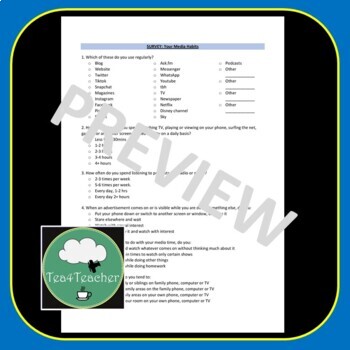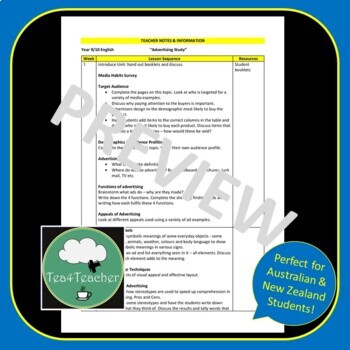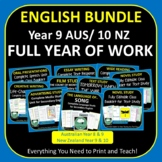ADVERTISING STUDY Complete Secondary Unit High School ENGLISH
- PDF
What educators are saying
Also included in
- 12 COMPLETE UNITS plus Introductory Activities to walk Secondary English students in Year 9 (Australia) or Year 10 (New Zealand) through a FULL YEAR HIGH SCHOOL ENGLISH PROGRAM of Novel Study, Text Response Essay, Creative Writing Unit, Wide Reading Unit, Oral Presentations (speeches), Advertising SPrice $73.00Original Price $84.50Save $11.50
Description
This complete unit walks Secondary English students step-by-step through a high-school style Advertising Language Unit. Perfect for Year 9 or Year 10 English looking at visual and verbal language techniques used in the media, particularly advertising.
This unit is all about looking at a range of visual and verbal language techniques used in advertising, analysing advertisements, creating an advertisement of their own, and completing an independent advertising analysis.
The print-and-go student booklet is accompanied by all teacher notes, a unit plan, keys for marking and advertising examples.
Includes:
1. A 32-page print-and-go student booklet with -
- Pre-unit survey
- visual and verbal language terms for advertising
- appeals of advertising
- Analysing adverts using an analysis grid
- Stereotypes, symbols in advertising
- Slogans
- How to write about language techniques
- Task sheets
- Planning and writing pages
- Sample essay marking schedule
- and so much more...
2. Teacher Resources, including:
- A teacher unit plan,
- Answer keys and notes
- Example analysis sheet
- Adverts
This complete media unit / language study unit is suitable for all classes at the secondary level in Australia & New Zealand who are learning to analyse and understand a variety of texts. I have taught in both countries and used the same unit with great success - you may need to tweak the assessment schedule to suit your system. Particularly for students of approximately 13-15 years of age: New Zealand Year 9, 10 or 11 students, Australian Year 8, 9 or 10 students, and UK Key Stage 3 students.
Note: This product has British English spelling throughout.
**********************************************************
Check out my other English Language Arts Resources for Secondary Students!
Checkout my English Language Arts Writing and Essay Writing Resources!
Check out my Classroom Posters!
**********************************************************
Get TpT credit to use on future purchases:
Log in and go to your “My Purchases” page. Click on the “Provide Feedback” button next to your purchase. You can leave a review for the product, and will earn credits toward your next paid product on TPT.






